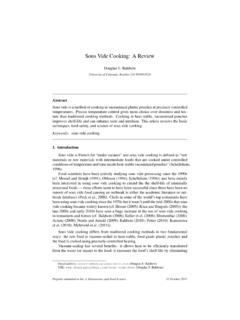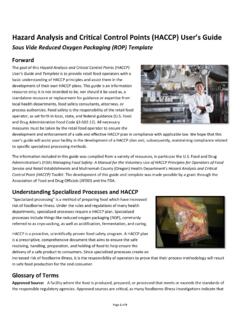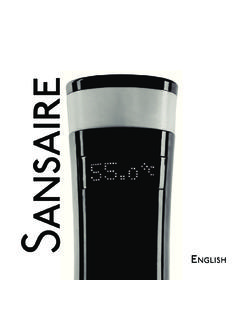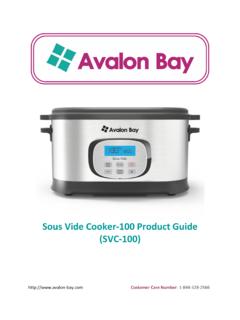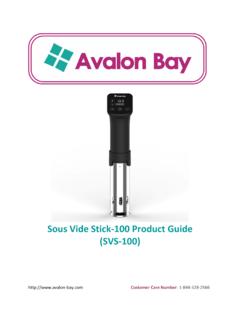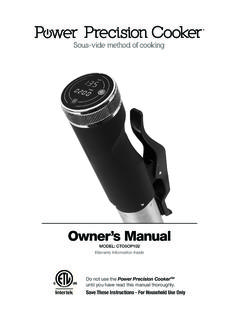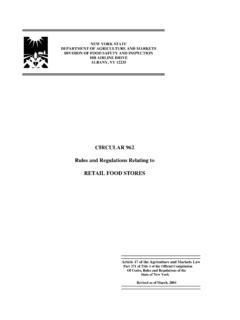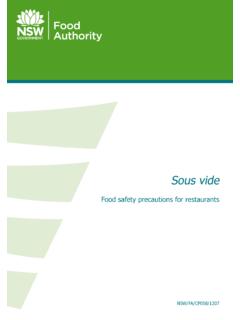Transcription of Sous vide cooking and chemistry - Douglas Baldwin
1 Sous vide cooking and chemistryDouglas E. BaldwinDepartment of Applied MathematicsUniversity of Colorado at BoulderACS Webinar May 9, often do you cook?(a)Cook almost everyday.(b)Not daily, but quite a lot.(c)Only for special occasions.(d)Almost vide/su: vi:d/adjectival & adverbial [ French, fromsousunder+videvacuum.]Of food: (prepared) by cooking invacuumized pouches at preciselycontrolled food temperatures Beef, lamb, and pork 50 CRare 55 CMedium-rare 60 CMedium>70 CWell done Fish and shellfish 49 CMedium-rare Baked goods 90 CBreads, rolls, muffins, kitchen heat sources 70 CSlow-cooker100 CBoiling water125 200 COven150 250 CSkillet200 350 CGrill1500 2000 vide cooking : Cook at the food s optimal temperature.
2 If 55 C is medium-rare,then use a 55 C water-bath)meat can t exceed 55 C)nothing overcooked)medium-rare from edge to benefits Removing air improves heat transfer Increases shelf-life Food can t be recontaminated Inhibits off-flavors from oxidation Reduces aerobic bacterial growth Improves nutrition and flavor Stops flavor volatile evaporation Stops nutrients leaching into Soft-cooked eggs Protein denaturation Beef chuck roast How heating changes meat Extended heating tenderizes Chicken breasts Pasteurizing for denaturation Heat cooking , baking.
3 Mechanical agitation whipping pH change vinegar, lemon juice, .. Inorganic salts curing and brining Organic compounds alcohol marinades Detergents temperatures in 75 C water51015202530 TimeHminL10203040506070 TempH CLMeasured yolk temperatures of 14 chicken rate Temperature Arrhenius reactions:10 C increase roughly doubles rate Yolk denaturation:1 C increase roughly doubles rate Catalysts Enzymes catalyze biochemical reactions you grill meat or poultry, do you(a)always use a thermometer to see when it sdone,(b)sometimes use a thermometer, or(c)never use a thermometer?
4 Meat proteinsMeat s about 75% water, 20% protein,and 5% fat and other : Muscle fibers mostly myosin & actin Soluble proteins mostly enzymes and myoglobin Connective tissue mostly collagen, less protein denaturingIn traditional cooking when heating: Muscle fibers shrinkstarting 35 40 C up to 80 C Soluble proteins aggregate and gelstarting 40 C and finishing 60 C Connective tissues shrinkstarting 60 andmore intensely above 65 CRare muscle fibers andsoluble proteins start denaturing55 CMedium-rare more muscle fibers andsoluble proteins denature60 CMedium most soluble proteins denatured>70 CWell done connective tissue start denaturing muscle fibers squeeze out you eat beef, do you prefer it(a)rare,(b)medium-rare,(c)medium, or(d)
5 Well done?..If 55 C is medium-rare,why not cook at 55 C?You can with sous vide reactions tenderizeHolding meat at 55 60 C for hoursto days increases tenderness because Enzymes can catalyzeconnective-tissue protein hydrolysis Collagen slowly starts to denaturearound 51 to 53 chuck or Maillard reaction Roast and savory flavors Starts noticably 130 C Good browning starts 150 makes lamb taste like lamb and beef taste like reaction Complex reaction betweenamino acids and reducing sugars Produces hundreds of reaction by-products Reaction rate
6 Increased by Increasing temperature Adding a reducing sugar Increasing the browning methods Beef and lamb Butane blowtorch Very hot grill or broiler Chicken and pork Pan with smoking-hot oil Shimmering oil with 4% glucose wash Very hot grill or chuck water to 55 C for medium-rare2.( ) Pre-sear with blowtorch or roast in a large into water bath for 1 2 from pouch and pat each side to a mahogany and serve do you stop cooking a chicken breasts?(a)When it s juices run clear.(b)When it s white when you cut into it.
7 (c)When it reaches 75 C/165 F.(d)When it s dry and stringy.(e)Some other ways to reduce pathogens Heat both time and temp important Inorganic salts curing pH changes acidifying Herbs and spices essential oils Mechanical agitation very high pressures Alcohol marinades Ionizing radiation not for home Danger Zone ? Traditional danger zone is 5 to 60 C Food pathogens don t grow below-1:3 C Food pathogens don t grow above 52:3 C Dangerous growth takes days at 5 C Pasteurization takes 43 min at 60 Cbut 3 hr 20 min at 55 reduces risk Reduce but can t eliminate pathogens Healthy may need 105to 109to get sick Immunocompromised 1 10/g to get sick 15 20% of US immunocompromised 106!
8 1 reduction usually of interest Salmonellaspecies Pathogenic strains ofEscherichia coli Listeria monocytogenes the toughest 106!1 after 2 min at 70 C 106!1 after 20 min at C 106!1 after 200 min at 55 C Spore forms, like vide chicken water bath to 60 vacuum-seal the sealed pouches in water them for at least 2 from bath and pouches. Pat in a skillet with smoking-hot time and chops Medium-rare to medium)55 60 C Moderately tender)short to moderate cooking times 60 C & 20 mm thick)1 hours to mignon Rare to medium-rare)50 55 C Prized tenderness)short cooking time 50 55 C & short time)can t pasteurize)healthy people only 50 C)pathogen growth)minimize time 55 C)short timeormushy Resources Free sous vide cooking guide YouTube video demos Review article [IJGFS vol.]
9 1 (2012) pp. 15 30] sSous Vide for the Home Cook(2010) Over 200 recipes Less technical than website or review article Other food science books: H. McGee sOn Food and cooking (2004) N. Myhrvold et al. sModernist Cuisine(2011)
